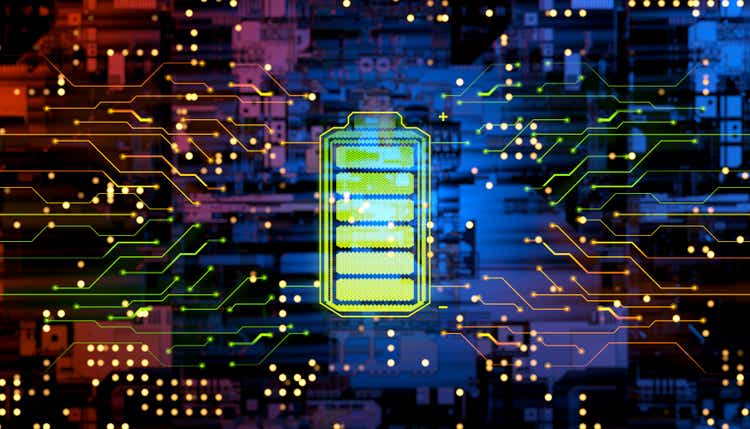MF3d
By Christopher Gannatti, CFA
The other day, the following headline caught my eye:
Tesla Supplier Panasonic Plans Additional $4 Billion EV Plant in U.S.1
Even in an environment with significant inflation and a monetary policy that may continue raising rates for some time, significant capital expenditure continues within the battery space.
Panasonic is particularly notable because, in July 2022, it announced a plan to build a roughly $4 billion plant in Kansas. Now, one month later, it is announcing another plan for a roughly $4 billion plant in Oklahoma.2
The concept of securing certain supply chains globally has been a major theme in 2022, even if it gets obscured by inflation, U.S. Federal Reserve activities or the possibility of a recession. Semiconductors have been a big focus on that list, but so have the batteries that support the ongoing adoption of electric vehicles.
Geopolitics is always in the background of these supply chain considerations. While Panasonic (PCRFY, Japan) and LG Energy Solution Ltd. (South Korea) have made announcements in 2022 about plans to build plants directly in the U.S., Contemporary Amperex Technology Co. (CATL) – China’s top EV battery maker – has not been able to do the same. There was a plan in place, but U.S.-China tensions have recently ratcheted up, leading to postponement.3
I can also note that over the couple of days I spent drafting this very blog post, I saw another headline pop up:
Honda, LG Energy Plan $4.4 Billion EV Battery Factory in U.S.4
It’s certainly an area in focus.
Where Is EV Adoption in the U.S. Currently?
For the full U.S. market, roughly 6% of new vehicles are electric. California, however, saw 16% of new vehicle sales in the second quarter of 2022 be EVs.5
There is an interesting contrast between California and other states in the U.S. The European Union announced that new cars must be free from emissions after 2035.6 Many individual countries had already made similar plans. Norway’s government has a plan to not sell any new petrol or diesel cars from 2025 onward, and 70% of new cars sold in Norway in 2020 were electric7.
The individual states across the U.S., on the other hand, have not signaled commitments anywhere close to this, at least not yet…with the exception of (you guessed it) California!
New regulations applying to new cars, pickup trucks and SUVs would establish annual thresholds for the share of zero-emissions vehicles automakers must sell in the state each year8.
The Clean Air Act of 1970 granted California a waiver to set its own environmental rules, and this allows for stricter standards than other states across the U.S. Other states can adopt California’s rules. For those following politics:9
- The Trump Administration in 2019 stripped California of its waiver. Some companies still voluntarily sought to meet California’s stricter standards, but there was a division.
- The Biden Administration then gave California back its waiver in March 2022, which allowed for these new rules.
Depending on the path of U.S. politics, we’ll have to see how the story continues to evolve – but with each passing year, it is doubtful that politicians would be able to fully stop the trend of EV adoption. Maybe it will slow, and certain states will hold out, but even the automakers themselves are noting a desire to go fully electric in their production within the coming decades.
Hydrogen?
One thing we know about hydrogen is that the market loves to “hype” this concept. Even though the full development of an infrastructure that would support the use of hydrogen at scale will take years – possibly a lot of years – at the end of 2020 and start of 2021 many of the firms focused on hydrogen had sky-high valuations10. The market wanted to price these firms as though the potential had already been realized – so we know that returns have been much harder to come by in the space in most of 2021 and 2022 so far.
Plug Power (PLUG) is one such company, and on August 25, 2022, it agreed to provide 10,950 tons per year of liquid green hydrogen, starting in 2025.11 Green hydrogen refers to the process used to produce the hydrogen being fully done by using renewable, carbon-emission-free energy. If Amazon (AMZN) wants to decarbonize its operations and use hydrogen to do it, it’s important that the production of the hydrogen isn’t simply moving the emissions generation from Amazon’s operations toward Amazon’s energy suppliers. Amazon has committed to be net zero in terms of carbon emissions by 2040.
As a rough guide, this amount of hydrogen that Plug Power would supply could power between 1,000 and 2,000 heavy-duty trucks over the course of a year.12 It is an area of active debate and development regarding the best way to decarbonize heavy-duty trucks:
- Current lithium-ion battery technology could work, but batteries would be very heavy, and the need to stop for charging could prove a challenge on longer-haul trips. Charging massive, semi-truck-sized batteries could also take much longer than charging batteries for passenger cars.
- Hydrogen offers interesting alternative benefits, but currently, the discussion should focus on the supply chain. First, the infrastructure of hydrogen fueling stations needs to be built out, securing the supply of hydrogen on major routes. Second, the production of hydrogen needs to be green, or else all the companies trying to use hydrogen as part of “net-zero” emissions plans would have to look elsewhere.
Our take on hydrogen for the moment is one of reasonable optimism, recognizing the benefits but at the same time not getting too excited too quickly.
Conclusion: Countries Want to Be Energy Independent
Decades ago, the only way countries could be energy independent was to find massive deposits of oil. While we still use fossil fuels globally, energy independence in the coming decades will likely look quite different, and the countries that secure the best possible energy storage technologies could be in the best position as they deploy all sorts of renewable energy technologies to power their needs.
To this end, there are going to be a lot of advances in regulations and energy storage technologies and, all the while, increases in capital expenditures to build out all sorts of infrastructure and production capability. Those interested in an investment specifically geared to take exposure to this topic should consider the WisdomTree Battery Value Chain and Innovation Fund (WBAT).
As of August 30, 2022, WBAT held 0.22%, 1.37% and 2.83% of its weight in Panasonic, LG Energy Solution Ltd. and Contemporary Amperex Technology Co., respectively.

Christopher Gannatti is an employee of WisdomTree UK Limited, a European subsidiary of WisdomTree Asset Management, Inc.’s parent company, WisdomTree Investments, Inc.
Footnotes
|
1 River Davis and Rebecca Elliott, “Tesla Supplier Panasonic Plans Additional $4 Billion EV Battery Plant in U.S.,” Wall Street Journal, 8/26/22. 2 Source: Davis, 8/26/22. 3 Source: Davis, 8/26/22. 4 River Davis and Dasl Yoon, “Honda, LG Energy Plan $4.4 Billion EV Battery Factory in U.S.,” Wall Street Journal, 8/29/22. 5 Mike Colias and Christine Mai-Duc, “California Approves Rules to Ban Gasoline-Powered Cars by 2035,” Wall Street Journal, 8/25/22. 6 EU agrees new cars must be emissions-free after 2035 | DW | 29.06.2022 7 https://www/statista.com/statistics/696187/electric-and-hybrid-cars-number-in-norway/ 8 Colias, 8/25/22. 9 Source: Colias, 8/25/22. 10 Source: Bloomberg. 11 Angela Palumbo and Al Root, “Plug Power Stock Jumps on Hydrogen Supply Deal with Amazon,” Barron’s, 8/25/22. 12 Palumbo, 8/25/22. |
Editor’s Note: The summary bullets for this article were chosen by Seeking Alpha editors.
Editor’s Note: This article discusses one or more securities that do not trade on a major U.S. exchange. Please be aware of the risks associated with these stocks.


Be the first to comment